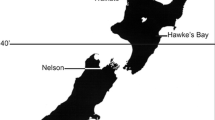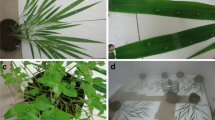Abstract
A viroid-incited disease characterized by pale fruits, crumpled flowers, and rugosity and chlorosis on the leaves of cucumber, occurs occasionally in cucumber crops grown in glasshouses in the Netherlands. The disease is found primarily in crops planted in spring, rarely in those planted in summer but not in those planted in late summer. The pathogen can be transmitted with sap, during pruning, by grafting and with dodder to cucumber and a number of other cucurbitaceous species, but not withM. persicae. There is no evidence for seed or nematode transmission. The incubation period is 21 days at high temperatures (30°C) but shorter after inoculation by razorbalade slashing.
The number of glasshouses with the disease has increased since 1965, but the number of diseased plants is usually low. The initial distribution of diseased plants in the glasshouses suggests that the pathogen is introduced by an insect.
Samenvatting
Een door een viroïd veroorzaakte ziekte die bleke vruchten, verfrommelde bloemen, diepnervigheid en later bladchlorose veroorzaakt, wordt zo nu en dan op komkommers, die in warenhuizen worden geteeld, aangetroffen (Fig. 1–3). De ziekte wordt voornamelijk gevonden op die gewassen die in de winter en het voorjaar worden geplant en niet op die, welke's-zomers of in de herfst worden geplant.
De veroorzaker van deze ziekte kan mechanisch van komkommer naar komkommer en andere komkommerachtigen, zoals augurk, watermeloen en suikermeloen, worden overgebracht (Fig. 4–9; Tabel 1). Het pathogeen is ook metCuscuta en door enting over te brengen en kan met snoeigereedschap worden verspreid. Overdracht met zaad,Myzus persicae of nematoden kon niet worden vastgesteld.
De incubatietijd, die onder praktijkomstandigheden ongeveer 6–8 weken is, kon tot ruin 3 weken worden teruggebracht door de planten bij 30°C te kweken (Tabel 2) en kon worden gereduceerd tot 12 dagen door het pathogeen over te brengen aan een scheermesje, waarmee kleine sneetjes worden aangebracht.
Het aantal bedrijven waarop de ziekte wordt gevonden neemt sinds 1965 toe (Tabel 3). Mogelijk is dit toe te schrijven aan het aantal telers dat de ziekte kan herkennen. Het aantal besmette planten in een warenhuis is gewoonlijk laag. Het vóókomen en de verspreiding van de zieke planten in een warenhuis suggereert dat de ziekte door een insekt in het warenhuis wordt binnengebracht.
Similar content being viewed by others
References
Diener, T. O., 1971. Potato spindle tuber ‘virus’. IV. A replicating low molecular weight RNA. Virology 45: 411–428.
Diener, T. O., 1972. Potato spindle tuber viroid. VIII. Correlatin of infectivity with a UV-absorbing component and thermal denaturation properties of the RNA. Virology 50: 606–609.
Diener, T. O. & Lawson, R. H., 1973. Chrysanthemum stunt: a viroid disease. Virology 51: 94–101.
Hollings, M. & Stone, O. M., 1973. Some properties of chrysanthemum stunt, a virus with the characteristics of an uncoated ribonucleic acid. Ann. appl. Biol. 74: 333–348.
Lee, C. R. & Singh, R. P., 1972. Enhancement of diagnostic symptoms of potato spindle tuber virus by manganese. Phytopathology 62: 516–520.
Sänger, H. L., 1972. An infectious and replicating RNA of low molecular weight: the agent of the exocortis disease of citrus. Adv. Biosci. 8: 104–116.
Semancik, J. S. & Weathers, L. G., 1972. Exocortis disease: evidence for a new species of ‘infectious’ low molecular weight RNA in plants. Nature New Biology 237: 242–244.
Singh, R. P. & Clark, M. C., 1971. INfectious low molecular weight ribonucleic acid from tomato. Biochem. Biophys. Res. Comm. 44; 1077–1083.
Weathers, L. C., 1964. Nitrogen as a factor in the development of exocortis of citrus. Phytopathology 54: 968–969.
Author information
Authors and Affiliations
Rights and permissions
About this article
Cite this article
van Dorst, H.J.M., Peters, D. Some biological observations on pale fruit, a viroid-incited disease of cucumber. Netherlands Journal of Plant Pathology 80, 85–96 (1974). https://doi.org/10.1007/BF01980613
Accepted:
Issue Date:
DOI: https://doi.org/10.1007/BF01980613




